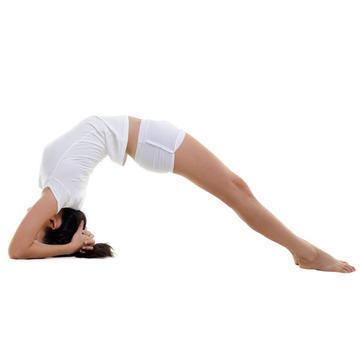Strengthens Shoulder Pose type Backbend, Chest opener | Stretches Front of body | |
 | ||
Note Consult a doctor before beginning an exercise regime Preparatory poses Chakrasana, Janusirsasana, Purvottanasana Follow-up poses Adho mukha śvānāsana, Uttanasana, Marichyasana I Similar Dandasana, Viparita Karani, Eka Pada Koundinyasana I, Chakrasana, Adho mukha śvānāsana | ||
Dwi Pada Viparita Dandasana (Sanskrit: द्विपादविपरीतदण्डासन; IAST: Dvi Pāda Viparīta Daṇḍāsana) or Two-Legged Inverted Staff Pose is an asana and is a combination of Sirsasana (headstand) and Urdhva Dhanurasana (upward facing bow pose).
Contents
Etymology
The name comes from the Sanskrit words dwi (द्वि, dvi) meaning "two", pada (पद, pāda) meaning "foot", viparita (विपरीत, viparīta) meaning "inverted", danda (दण्डा, daṇḍā) meaning "staff", and asana (आसन, āsana) meaning "posture" or "seat".
Description
From Urdhva Dhanurasana, bend the arms and place the crown of the head on the floor between the hands. On an exhale, lower one forearm to the floor, followed by the other, and interlace the fingers behind the head, as in sirsasana. Firm the outer arms inwards, soften and widen the shoulder blades and press downward evenly through the entire edge of the forearm, lifting the thoracic spine. Soften the buttocks, lengthen the tailbone towards the pubis and spiral the inner thighs towards the inner groins, elevating the hips. On an exhale, press down evenly through the wrists, forearms and elbows to lift the chest and crown of the head away from the floor. Slowly walk each leg out in front of the body until they are almost straight. On an exhale, press through the inner feet, and stretch through the calves to straighten the legs completely. According to some yoga styles, this asana should be practiced with Ujjayi breathing.
To come out of the asana, un-straighten the legs by bending one leg and then the other so that the ankles are below the knees. Lower the crown of the head to the floor, undo the clasping of the hands, and press back into Urdhva Dhanurasana. Release as one normally would from that asana.
Benefits
Contraindications
Back injuries, shoulder injuries, high blood pressure.
Variations
Eka Pada Viparita Dandasana
